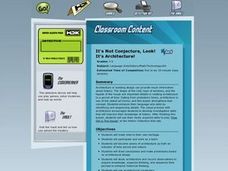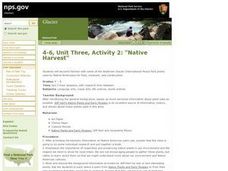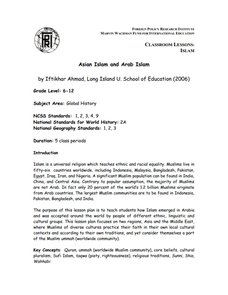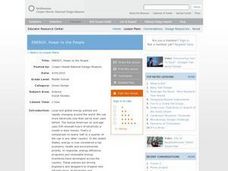National Endowment for the Humanities
Kate Chopin's "The Awakening": No Choice But Under?
The first in a series of three resources designed to accompany a reading of Kate Chopin's The Awakening provides readers with background information about Chopin, Creole culture, literary realism, and women's suffrage.
Curated OER
Politics in Your Own Back Yard
Young scholars take a closer look at local government in Britain today. In this current events lesson plan, students visit selected websites to discover a history of county councils and neighborhood authorities. Young scholars...
Curated OER
Famous Landmarks
Students investigate countries by identifying their national landmarks. In this World Geography lesson, students utilize the Internet to research a historic landmark in a foreign country and complete a landmark survey worksheet....
Curated OER
It's Not Conjecture, Look! It's Architecture!
Students examine how architecture reflects historical time periods. They conduct research on the History Detectives website, complete a fact sheet, sequence photographs of different architectural styles, and create an illustration of a...
Curated OER
Comparison of American Colonies
Students explore the lifestyles of the American colonies. They conduct various activities according to their grade level including jigsaw research and creating a poster. Lesson includes primary source readings related to the topic.
Curated OER
Class Mural
Students discover visual arts by examining a wall mural. In this art appreciation lesson, students discuss the history of art after researching information on the Internet. Students view famous paintings which feature physical movement...
Curated OER
Children Around the World: Child Labor
Learners research the history of child labor and the child labor that still exists in the world today.
Curated OER
Watershed Documentary
Students research and produce an iMovie documentary about the human and natural history of a stream basin (watershed).
Curated OER
Maps and Local History
Students study old and current maps of their town. They make connections between the geography of a town and the activities of its inhabitants.
Curated OER
Native Harvest
Students read Native Plants and Early Peoples and explore the plants in Waterton-Glacier International Peace Park and find how the Native Americans used them. In this Native American plant and people instructional activity, students...
Curated OER
Tintin and I: Primary and Secondary Sources
Mickey Mouse, Elmo, and Tintin? Belgian cartoonist Georges (Herge) Remi’s famous comic character launches a study of primary and secondary source material and the impact these sources have on storytelling. Class members also examine the...
Robert F. Kennedy Center for Justice and Human Rights
Vaclav Havel: Free Expression
Develop an understanding of universal human rights, particularly the freedom of expression, with the questions and activities that analyze the conflicts of Vaclav Havel. Learners define, interpret and rephrase the human rights article in...
Curated OER
Neighborhood or Slum? Snapshots of Five Points: 1827-1867
How has your local neighborhood changed throughout recent history? Young researchers evaluate census data, images, and primary source descriptions describing the living situation in the antebellum Five Points neighborhood. They consider...
Foreign Policy Research Institute
Asian Islam and Arab Islam
Focus on the impact and practice of Islam throughout Asia and the Middle East. Learners review the seven major religions, the spread of Islam, and Islamic tenets commonly practiced. They then research one country that practices Islamic...
Curated OER
Medieval Clothing and Fashion
Students examine the clothing of medieval times. In this Middle Ages activity, students view their instructor in the clothing of the era. Students then research the clothing worn by the people of the time period and create booklets that...
Curated OER
Biography of a river
Students compare and contrast facts about the development, history and importance of several rivers in the state. They research the history and development of one particular river and describe the deltas and their formation.
Curated OER
Then, Now, and Tomorrow
Students will use this unit to investigate the past, present, and future of the architecture and plan of New York's Lower East Side. Students will research the history of the Lower East Side neighborhood in photographs used from the...
Curated OER
Plotting Slave Population Density in Connecticut in the 1700's
Tenth graders explore slavery in the U.S. by researching the web. In this U.S. history lesson, 10th graders identify the geography of Connecticut and the overall involvement the state had in the slavery process. Students view data of the...
Curated OER
Energy: Power to the People
Students explore the concept of renewable energy. In this green design lesson, students research local energy issues facing their community and create policies to address the issues.
Constitutional Rights Foundation
Educating About Immigration The DREAM Act
Group members role play state legislators, supporters of and opponents to the The DREAM Act (Development, Relief, and Education for Alien Minors). After listening to the arguments put forth for and against the immigration legislation,...
Curated OER
Trekking to Timbuktu: A Center of Trade
Learners conduct online research regarding the origins of the city of Timbuktu and discover why it became such an important place. Students write about the city's origins until it became a part of Mali.
Anti-Defamation League
The Hate U Give
The Hate U Give by Angie Thomas became a quick hit in the young adult literature genre before its adaptation in the 2018 film of the same name. Use a thorough lesson, discussion guide, and series of activities to discuss the social...
ProCon
Voting Machines
Does technology always mean advancement? Scholars take a close look at the use of voting machines. Does using a machine make voting more effective? Readers consider the advantages and disadvantages of the current voting process. They...
Curated OER
The Sound of History: Conducting an Oral Interview
Students conduct an oral interview with a person from their local community. They conduct research, write interview questions, conduct the interview, and identify the subject matter using headings and subheadings.

























